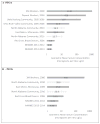Per- and polyfluoroalkyl substances in human serum and urine samples from a residentially exposed community
- PMID: 28645013
- PMCID: PMC5673082
- DOI: 10.1016/j.envint.2017.06.007
Per- and polyfluoroalkyl substances in human serum and urine samples from a residentially exposed community
Abstract
Background: Per- and polyfluoroalkyl substances (PFAS) are considered chemicals of emerging concern, in part due to their environmental and biological persistence and the potential for widespread human exposure. In 2007, a PFAS manufacturer near Decatur, Alabama notified the United States Environmental Protection Agency (EPA) it had discharged PFAS into a wastewater treatment plant, resulting in environmental contamination and potential exposures to the local community.
Objectives: To characterize PFAS exposure over time, the Agency for Toxic Substances and Disease Registry (ATSDR) collected blood and urine samples from local residents.
Methods: Eight PFAS were measured in serum in 2010 (n=153). Eleven PFAS were measured in serum, and five PFAS were measured in urine (n=45) from some of the same residents in 2016. Serum concentrations were compared to nationally representative data and change in serum concentration over time was evaluated. Biological half-lives were estimated for perfluorooctanoic acid (PFOA), perfluorooctane sulfonic acid (PFOS), and perfluorohexane sulfonic acid (PFHxS) using a one-compartment pharmacokinetic model.
Results: In 2010 and 2016, geometric mean PFOA and PFOS serum concentrations were elevated in participants compared to the general U.S.
Population: In 2016, the geometric mean PFHxS serum concentration was elevated compared to the general U.S.
Population: Geometric mean serum concentrations of PFOA, PFOS, and perfluorononanoic acid (PFNA) were significantly (p≤0.0001) lower (49%, 53%, and 58%, respectively) in 2016 compared to 2010. Half-lives for PFOA, PFOS, and PFHxS were estimated to be 3.9, 3.3, and 15.5years, respectively. Concentrations of PFOA in serum and urine were highly correlated (r=0.75) in males.
Conclusions: Serum concentrations of some PFAS are decreasing in this residentially exposed community, but remain elevated compared to the U.S. general population.
Keywords: Biomonitoring; Half-life; PFAS; PFOA; PFOS.
Published by Elsevier Ltd.
Conflict of interest statement
None.
Figures


Similar articles
-
Per- and polyfluoroalkyl substance (PFAS) exposure assessment in a community exposed to contaminated drinking water, New Hampshire, 2015.Int J Hyg Environ Health. 2018 Apr;221(3):569-577. doi: 10.1016/j.ijheh.2018.02.007. Epub 2018 Feb 20. Int J Hyg Environ Health. 2018. PMID: 29514764
-
Quantifying levels of per- and polyfluoroalkyl Substances (PFAS) in water and serum after contamination from agricultural biosolid application.Environ Int. 2024 Aug;190:108850. doi: 10.1016/j.envint.2024.108850. Epub 2024 Jun 24. Environ Int. 2024. PMID: 38941944
-
Per- and polyfluoroalkyl substances (PFAS) exposure in the U.S. population: NHANES 1999-March 2020.Environ Res. 2025 Apr 1;270:120916. doi: 10.1016/j.envres.2025.120916. Epub 2025 Jan 21. Environ Res. 2025. PMID: 39848516 Free PMC article.
-
United States Environmental Protection Agency's Perfluorooctanoic Acid, Perfluorooctane Sulfonic Acid, and Related Per- and Polyfluoroalkyl Substances 2024 Drinking Water Maximum Contaminant Level: Part 2 - Fifteen Misconceptions About the Health Hazards.Crit Rev Toxicol. 2025;55(3):368-415. doi: 10.1080/10408444.2024.2446453. Epub 2025 May 20. Crit Rev Toxicol. 2025. PMID: 40391660 Review.
-
Systematic review and meta-analysis of epidemiologic data on vaccine response in relation to exposure to five principal perfluoroalkyl substances.Environ Int. 2023 Feb;172:107734. doi: 10.1016/j.envint.2023.107734. Epub 2023 Jan 7. Environ Int. 2023. PMID: 36764183
Cited by
-
Perfluoroalkyl and polyfluoroalkyl substances (PFAS) and their effects on the ovary.Hum Reprod Update. 2020 Sep 1;26(5):724-752. doi: 10.1093/humupd/dmaa018. Hum Reprod Update. 2020. PMID: 32476019 Free PMC article.
-
Temporal trends of concentrations of per- and polyfluoroalkyl substances among adults with overweight and obesity in the United States: Results from the Diabetes Prevention Program and NHANES.Environ Int. 2021 Dec;157:106789. doi: 10.1016/j.envint.2021.106789. Epub 2021 Jul 29. Environ Int. 2021. PMID: 34333293 Free PMC article.
-
PFAS in Nigeria: Identifying data gaps that hinder assessments of ecotoxicological and human health impacts.Heliyon. 2024 Apr 21;10(9):e29922. doi: 10.1016/j.heliyon.2024.e29922. eCollection 2024 May 15. Heliyon. 2024. PMID: 38694092 Free PMC article. Review.
-
Concentrations and association between exposure to mixed perfluoroalkyl and polyfluoroalkyl substances and glycometabolism among adolescents.Ann Med. 2023 Dec;55(1):2227844. doi: 10.1080/07853890.2023.2227844. Ann Med. 2023. PMID: 37354023 Free PMC article.
-
A State-of-the-Science Review of Interactions of Per- and Polyfluoroalkyl Substances (PFAS) with Renal Transporters in Health and Disease: Implications for Population Variability in PFAS Toxicokinetics.Environ Health Perspect. 2023 Jul;131(7):76002. doi: 10.1289/EHP11885. Epub 2023 Jul 7. Environ Health Perspect. 2023. PMID: 37418334 Free PMC article. Review.
References
-
- Alexander BH, Olsen GW. Bladder cancer in perfluorooctanesulfonyl fluoride manufacturing workers. Ann Epidemiol. 2007;17:471–478. - PubMed
-
- Andersen ME, Clewell HJ, 3rd, Tan YM, Butenhoff JL, Olsen GW. Pharmacokinetic modeling of saturable, renal resorption of perfluoroalkylacids in monkeys–probing the determinants of long plasma half-lives. Toxicology. 2006;227:156–164. - PubMed
-
- ATSDR. Exposure Investigation Report - Perfluorochemical Serum Sampling in the Vicinity of Decatur, AL, Morgan, Lawrence, and Limestone Counties. Division of Community Health Investigation; 2013. https://www.atsdr.cdc.gov/hac/pha/Decatur/Perfluorochemical_Serum%20Samp....
MeSH terms
Substances
Grants and funding
LinkOut - more resources
Full Text Sources
Other Literature Sources
Research Materials

